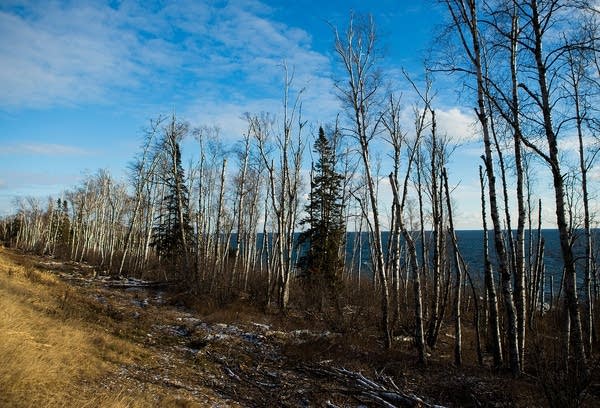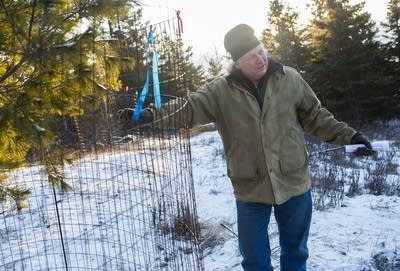Dead birch trees tell story of drastic change on North Shore
Go Deeper.
Create an account or log in to save stories.
Like this?
Thanks for liking this story! We have added it to a list of your favorite stories.

Anyone who has driven along the North Shore of Lake Superior recently has likely noticed huge stands of dead birch trees.
On a spot along Highway 61 where the Split Rock River spills into Lake Superior, for example, there is a hillside of dead and dying paper birch trees.
"This is a classic shot of declining birch," said Harley Hanson, a North Shore resource specialist for the state Department of Natural Resources. Historically there weren't many birch trees along the North Shore. But they sprouted like weeds after heavy pine logging and severe forest fires in the 1920s.
In recent years, several factors, including hungry deer, drought, development and thin, rocky soil, have drastically changed the forest in one of Minnesota's most popular and scenic areas.
Turn Up Your Support
MPR News helps you turn down the noise and build shared understanding. Turn up your support for this public resource and keep trusted journalism accessible to all.
To address the area's decline, the U.S. Forest Service is preparing an ambitious new plan to restore 12,000 acres of forest along the North Shore, where Hanson, who is based at Split Rock State Park, has spent nearly 15 years waging a battle against decay. Indeed, he has been something of a Johnny Appleseed, planting trees in the seven state parks along the shore.
As Hanson recently hiked over a fresh carpet of snow that blanketed the Superior Hiking Trail, he lamented the absence of young trees of any kind to replace the birch.
"You can see that there's very little stump sprouting going on as the trees are declining," he said.
Normally tiny birch saplings would jut from the bases of decaying trees. Instead, the landscape is littered with dead limbs, a few tiny spruce saplings poking through the snow and shrubs with the tips of their branches gnawed off.
The culprits, Hanson said, are deer. The animals flock in droves to the lakeshore in the winter, where it is warmer than the Iron Range but still bitterly cold.
"I mean, look at this. This is just incredible browse," he said. "As you can tell, this is a very popular area for deer to spend a little quality time most winter days."
To grow new trees in the spot, Hanson put metal fencing around young saplings to help them survive. Among them are a white pine tree planted in 1999.
Today, the tree is 20 feet tall, healthy and no longer vulnerable to deer, a fencing success story.
Several other parks, private landowners and groups like the Nature Conservancy are also planting and protecting trees.
Hanson said those efforts are only a drop in the bucket of what is needed along the 140-mile North Shore.
But they are the model for a Superior National Forest proposal to plant and protect trees on 12,000 acres of federal land, an effort that would focus on a 65-mile stretch from Grand Portage to Schroeder.
Becky Bartol, a forest service environmental coordinator for the Gunflint and Tofte District, said the plan has a much bigger scale than the typical reforestation project of only 1,000 acres.
"The reason for making it so ambitious is, we feel, ecologically, that's what it needs," Bartol said. "A lot of the public comments we get [are] 'It's about time somebody pay attention to the dying birch and did something.'"
There isn't a cost estimate yet, but reforestation is expensive. Hanson, of the DNR, estimates it costs between $1,000 and $2,000 to fence in a single acre to protect trees from deer. Planting trees costs nearly $250 an acre. But the project has a time horizon spanning decades.
Planners aim to foster a diverse mix of trees that contributes to a healthy ecosystem and can survive a warming climate. That means birch trees would have a lower priority. The primary goal is to restore white pine, spruce and cedar through a combination of planting, some thinning and selective logging, as well as installing barriers to keep out deer.
As Bartol stopped in an idyllic patch of forest on a visit, cold sunlight filtered through the canopy of towering old growth cedar. But on the forest floor, there was no new growth. She said that made it an ideal site for deer fencing.
"These cedars will stay here for quite a while," Bartol said. "But then what? If you aren't getting the regeneration of the cedar, then in 100 years, are you going to have any more cedar?"
The Forest Service hopes fencing such areas will allow the next generation of trees to take root. The agency is accepting comments on its proposal through Monday.
• Follow Dan Kraker on Twitter: http://twitter.com/dankraker
Dear reader,
Political debates with family or friends can get heated. But what if there was a way to handle them better?
You can learn how to have civil political conversations with our new e-book!
Download our free e-book, Talking Sense: Have Hard Political Conversations, Better, and learn how to talk without the tension.






